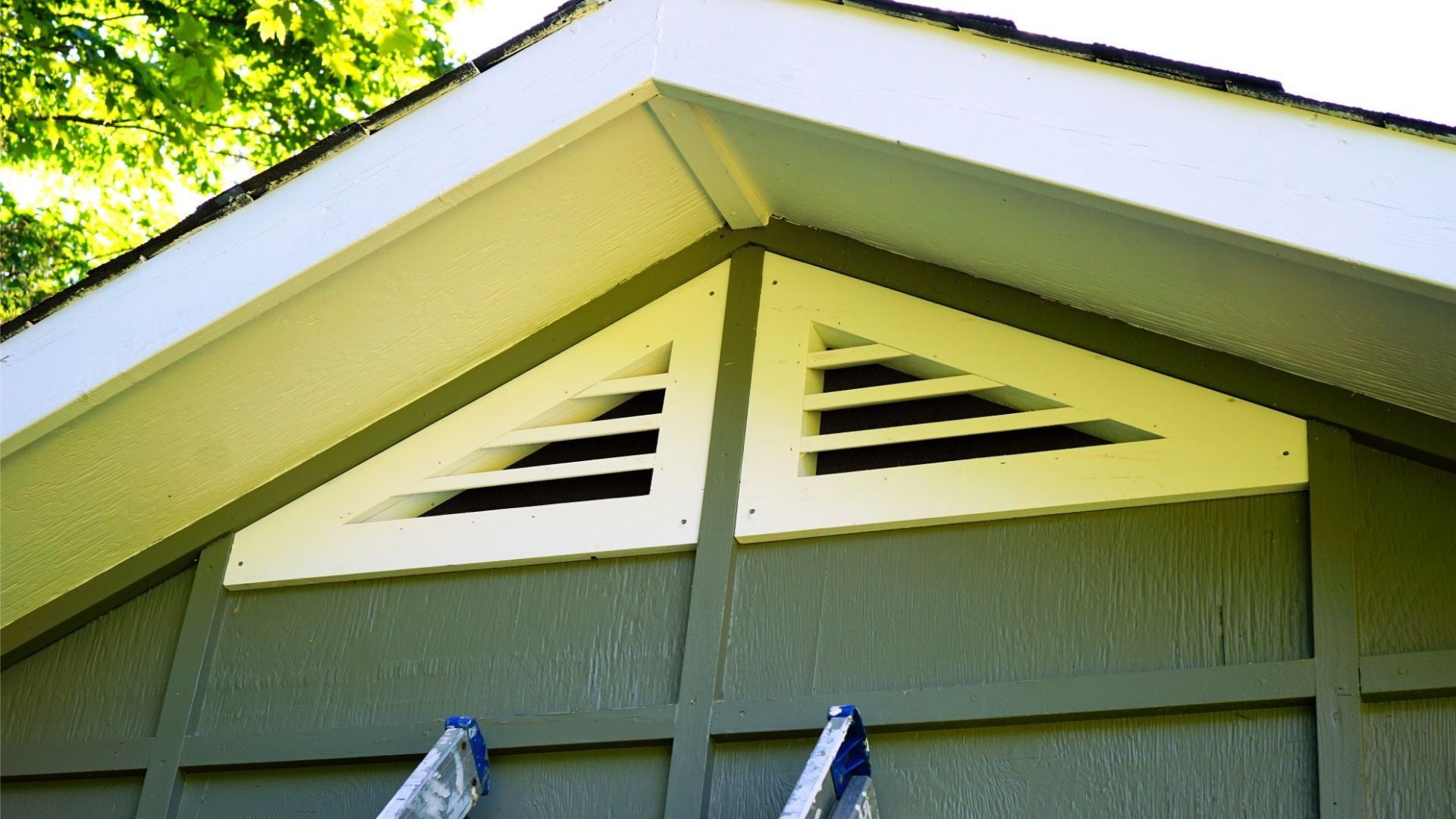Have you ever opened your garden shed on a warm day and been hit with a wave of stuffy, stale air? Or perhaps you've noticed some condensation on the inside of the windows, or worse, signs of mould or mildew on your stored items? These are clear signs that your garden shed requires better ventilation.
Proper garden shed ventilation is a crucial yet often overlooked aspect of shed maintenance. While garden sheds are excellent for storage, carrying out hobbies, or even as workspaces, they can also become hot, damp, and stuffy without adequate ventilation. This lack of fresh air can lead to many problems, from mould growth to wood rot, which could damage your shed and its contents.
But don't worry! Improving your garden shed's ventilation is often a simple task that you can DIY. And the numerous benefits - a well-ventilated shed means a fresher, drier interior and a longer life for your shed and everything inside it. Shall we get into it?
The Importance of Garden Shed Ventilation
An improperly ventilated garden shed can become a breeding ground for mould and mildew. These fungi thrive in damp, stagnant environments and can cause damage to both the structure of your shed and the items stored inside. Over time, this could lead to costly repairs or replacements.
Also, excessive dampness in your shed can lead to wood rot and corrosion of metal tools. Wood can soften and decay when exposed to constant moisture, leading to structural instability. On the other hand, metal objects may rust and deteriorate, shortening their useful life.
Another key reason to properly ventilate your garden shed is to regulate temperature. Sheds can become incredibly hot during the summer months. This heat can warp wooden items, dry out leather goods, and even cause certain chemicals to become volatile. Proper ventilation allows for a constant airflow, helping regulate the interior temperature.
Signs of Poor Ventilation in Your Garden Shed
Proper ventilation in a garden shed is critical to prevent moisture, heat, and air stagnancy issues. Detecting signs of poor ventilation early can help you take preventative measures to avoid problems such as mould growth, wood rot, and damage to your stored items. Here are some key signs to watch for:

Condensation on Windows
If you frequently find condensation inside your shed windows, it's a clear indicator of high humidity levels. This excess moisture in the air can condense on cooler surfaces like windows, signifying poor ventilation.
Musty Smell
A musty or stale smell is often a sign of stagnant air and excess moisture. This smell can indicate the presence of mould or mildew, both of which thrive in poorly ventilated areas.
Dampness on Walls or Floor
If you notice damp spots or pooling water on your shed's floor or walls, it's a strong sign that water isn't evaporating as it should, potentially due to inadequate ventilation.
Visible Mould or Mildew Growth
Mould and mildew appear as black, white, or green patches and can grow on virtually any surface in damp conditions. Their presence is a serious indicator of poor ventilation and high moisture levels.
Corrosion or Rust on Tools
Metal tools that start to rust are often a sign of excess moisture in the shed. While rust can occur over time, accelerated rusting can indicate a ventilation issue.
Warped Wood or Peeling Paint
High heat and humidity can cause wooden structures or items to warp. Similarly, peeling or blistering paint might indicate high moisture levels in the shed.
Extreme Temperature Variations
If your shed becomes excessively hot during the day and cold at night, it may not be ventilated well enough to moderate these temperature swings.
DIY Ventilation Solutions for Your Garden Shed
No matter your garden shed's size, improving your ventilation can be a straightforward DIY task. With a few strategic additions and changes to your shed's structure, you can significantly enhance air circulation, keeping your shed fresh and dry. Here are some detailed DIY solutions to consider:

Adding Vents
Installing vents is a cost-effective and efficient way to improve air circulation in your shed. You can install wall vents near the roof on opposite sides of the shed to allow cross-ventilation. As hot air rises, it will escape through the upper vents, drawing in cooler air from the lower ones. For more effectiveness, you could also add roof vents or ridge vents. These allow the hot air that has risen to the top of your shed to escape, promoting better air circulation.
Installing a Whirlybird
A whirlybird, or turbine vent, spins as the wind blows, drawing out hot, stale air inside the shed. This can be particularly useful during the hot summer months when the interior of your shed can become excessively warm. Installing a whirlybird involves cutting a hole in your shed's roof, fitting it, and sealing around it to prevent leaks.
Creating Cross Ventilation
Cross ventilation is achieved when air enters through an opening on one side of your shed and exits through an opening on the opposite side. This can be accomplished by strategically positioning doors and windows or adding additional vents on opposite walls of the shed. The goal is to create a steady flow of air that helps to regulate temperature and reduce moisture.
Regularly Opening Doors and Windows
This is perhaps the simplest method of all. Regularly opening your shed's doors and windows, especially during the warmer parts of the day, can help to refresh the air inside and reduce heat build-up.
Using a Solar-Powered Fan
A solar-powered fan can be an excellent solution for improving shed ventilation without electrical wiring. These fans use solar panels to generate the power needed to operate, helping to circulate air and reduce heat and moisture.
Maintaining a Fresh and Dry Garden Shed
Keeping your garden shed fresh and dry is an ongoing responsibility that requires regular maintenance and keen observation. Establishing a routine for regular checks is the first step towards effective shed maintenance. These checks, which could be monthly or quarterly, depending on your local climate and the time of year, are crucial for identifying any early signs of poor ventilation, such as increased condensation or visible mould growth.
During these inspections, you should focus on your shed's ventilation systems. Whether you have passive vents or active systems like whirlybirds or solar-powered fans, it's important to ensure they are clear of blockages and functioning as intended. Reduced airflow due to blockages can significantly impact the effectiveness of your ventilation, leading to increased humidity inside the shed.

Monitoring moisture levels within the shed is another important aspect of these regular checks. An increase in moisture can manifest in various ways, including a musty smell, damp spots on the walls or floor, and accelerated rusting of tools. Any of these signs should prompt an evaluation of your shed's ventilation and, possibly, an upgrade or enhancement to manage the humidity levels better.
The key to maintaining a fresh and dry garden shed is to address any issues promptly as they arise. For example, if you notice mould or mildew during your inspection, cleaning the affected area thoroughly and improving the ventilation in your shed is important. Timely interventions can prevent minor issues from turning into major problems that might be more difficult and costly.
Finally, remember that your shed's ventilation needs may vary throughout the year due to changes in weather and temperature. During hot summer months, for instance, you may need to increase ventilation to prevent heat build-up. Being responsive to these changing needs will go a long way in maintaining a fresh and dry garden shed.
Keep Your Garden Shed Fresh and Dry
Proper ventilation is crucial in maintaining a fresh and dry garden shed. It helps prevent moisture build-up, mould growth, temperature extremes, and damage to your belongings. By recognising the signs of poor ventilation and implementing the DIY solutions outlined in this article, you can significantly improve your shed's longevity and the condition of the stored items.
So, what are you waiting for? Get started today and give your garden shed the breath of fresh air it needs. And remember, if you're looking for more supplies to enhance your shed or garden, check out our range at Garden Depot. We're always here to help make your gardening journey a success.
Frequently Asked Questions about Garden Shed Ventilation
How often should I perform maintenance checks on my garden shed?
The frequency of maintenance checks can vary depending on local climate conditions and the time of the year. However, a general rule of thumb is to do a thorough check once every month or quarter to ensure everything is in good condition.
What are the signs of poor ventilation in my garden shed?
A: Signs of poor ventilation can include condensation on windows, a musty smell, damp spots on the walls or floor, visible mould or mildew growth, rust on tools, warped wood or peeling paint, and extreme temperature variations in the shed.
What are some DIY solutions for improving ventilation in my garden shed?
There are several DIY solutions for improving shed ventilation. These include adding wall or roof vents, installing a whirlybird, creating cross ventilation by strategically positioning doors and windows, and regularly opening the shed's doors and windows. A solar-powered fan can also be an effective solution.
How can I ensure that the moisture levels in my shed are under control?
Regularly monitoring your shed for signs of increased moisture, such as a musty smell, damp spots, and rusting on tools, can help keep moisture levels under control. If these signs are present, it may indicate a need to improve your shed's ventilation.
How can I adjust my shed's ventilation according to the changing seasons?
Depending on the time of the year and weather changes, you might need to adjust your ventilation strategies. For example, during hot summer months, increased ventilation may be needed to prevent heat build-up, while in rainy seasons, ensuring the vents are not allowing water to enter the shed becomes crucial.

